We have a strict honesty policy, but please note that when you buy through our links, we may earn a commission. Learn more.
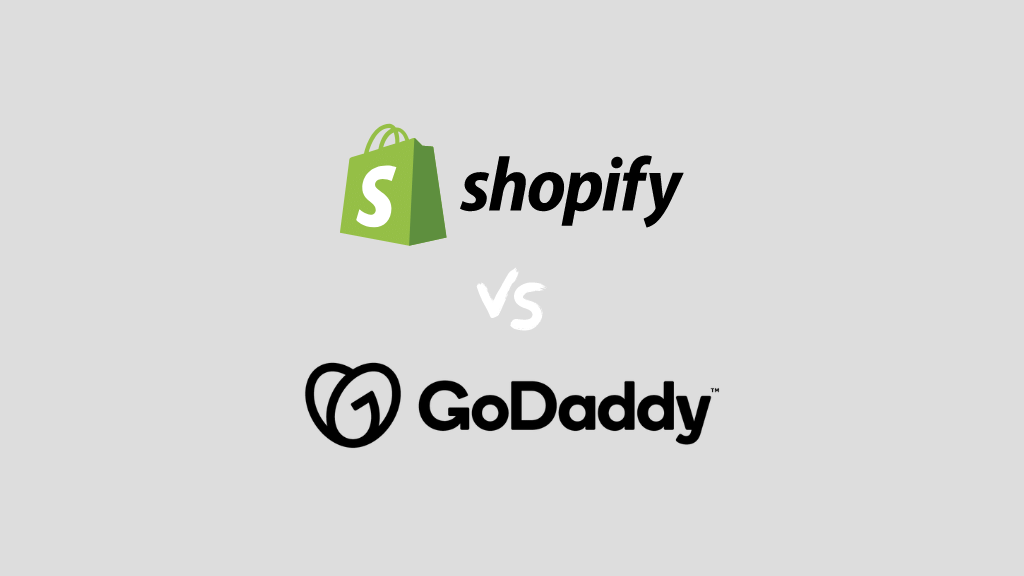
Shopify vs GoDaddy: which should you choose? In this detailed comparison, we take a look at both platforms and help you decide which is the best ecommerce solution for your business.
Let’s kick things off with a look at the background behind both platforms.
Shopify and GoDaddy: the background
On the surface, GoDaddy and Shopify look like quite different companies, offering quite different things.
Shopify is famous for being one of the most popular online store builders available. It started life in 2006 and nearly twenty years later, it powers over 5.5 million ecommerce websites (source: Builtwith.com).
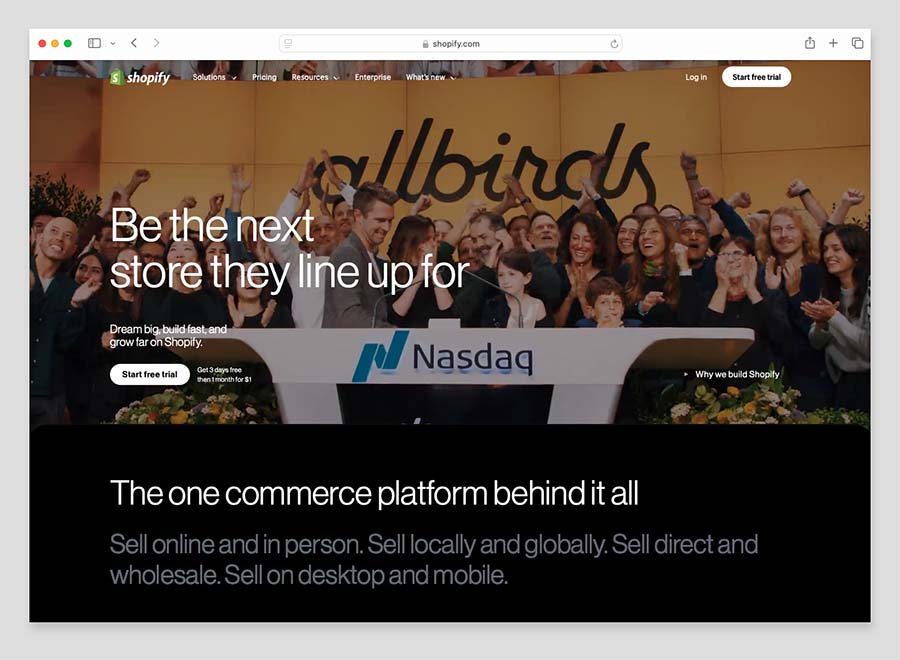
Founded in 1997, GoDaddy is best known as the world’s largest domain name and website hosting company, with over 82 million domains registered through it to date.
These days, however, GoDaddy offers a much wider range of online services — it’s not just about domain names and web hosting any more, but website building, ecommerce and digital marketing too.
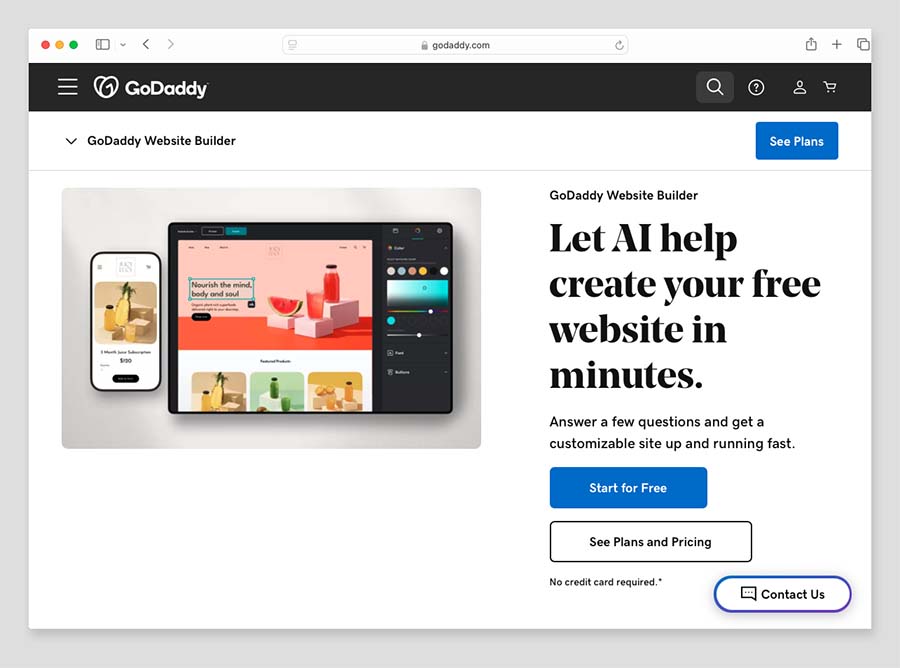
This means that you can now use both Shopify and GoDaddy to:
✓ create an online store (without coding knowledge)
✓ sell and ship products
✓ run marketing campaigns to promote your products
✓ sell products in physical locations.
I’m going to drill down into how good both products are at all this throughout the comparison.
Let’s start with pricing.
Pricing
GoDaddy pricing
There are three monthly pricing plans for the GoDaddy website builder available:
- Basic — $16.99 per month
- Premium — $29.99 per month
- Commerce — $34.99 per month.
GoDaddy offers discounts of 40% – 50% on these monthly fees for the first year if you pay for your plan upfront on an annual basis (see screenshot below).
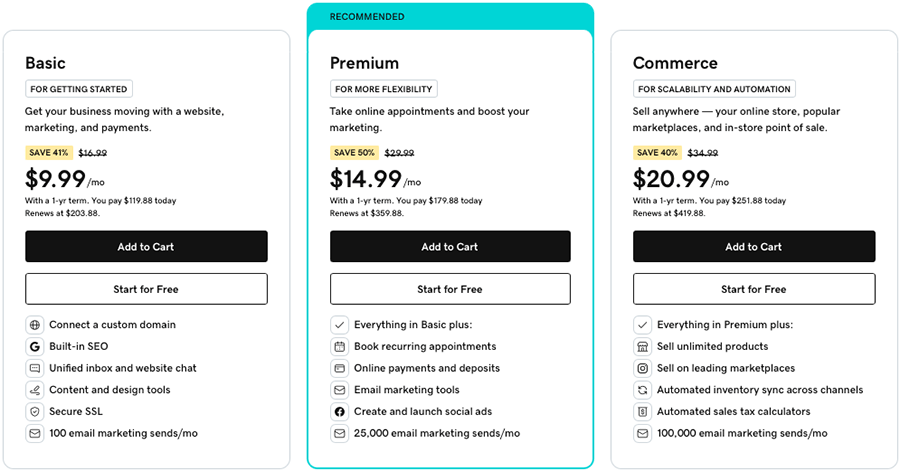
The good news is that with GoDaddy, you can start building a site or store entirely for free. However, it’s important to note that this option is quite basic — you can’t really sell anything on the free plan, and your site will display GoDaddy advertisements.
On the upside, you can use your free site indefinitely. You’ll only need to start paying when you decide to access the features included in the paid plans.
All GoDaddy pricing plans allow you to:
- create a site with its website builder
- connect a custom domain name to your site
- accept online bookings
- use ‘GoDaddy Payments’ to sell products in a physical store (USA and Canada only)
- access marketing analytics.
As you go up the GoDaddy pricing ladder, you get access to more features. And the main differences to watch out for between GoDaddy price plans are:
- Ecommerce — only the ‘Commerce’ plan lets you create a fully-functional, standalone online store.
- Search Engine Optimization (SEO): the ‘basic’ plan does not give you access to GoDaddy’s full SEO features.
- Recurring appointments: the ‘Premium’ and higher plans allow you to sell access to recurring events.
- Email marketing limits: this varies according to plan. The ‘Basic’ plan lets you send 100 emails per month; the ‘Premium’ lets you send 25,000; and the ‘Commerce’ plan facilitates 100,000.
Although its ‘Commerce’ plan is technically the only GoDaddy plan that lets you build an online store, it’s important to note that the other plans do facilitate some online selling.
If you’re selling services that don’t involve a physical product (consultancy services or online classes, for example), you can do that on GoDaddy’s ‘Premium’ plan; and you can use any paid-for GoDaddy plan to take in-person payments or send people payment requests.
But if you want to sell a catalog of physical goods on your online store, you should note that only the ‘Commerce’ plan let you do this.
Shopify pricing
Shopify gives you five pricing plans to choose from — and, unlike GoDaddy’s, they all allow you to sell physical products online. The available plans are as follows:
- Starter — $5 per month
- Basic — $39 per month
- Shopify — $105 per month
- Advanced — $399 per month
- Plus — custom pricing, but starting at $2,300 per month.
You can reduce these costs in a couple of ways.
First up, you can opt for an annual plan. Doing so will reduce your fees by 25%.
You can also lower your Shopify costs by making use of its new ‘credits’ system. This lets you put 1% of the revenue generated by your store towards your monthly Shopify fees. You can learn more about this new initiative here.
In terms of trials, Shopify gives you access to a 3-day one, which is very short by comparison to competing platforms. For a $1per month fee, you can extend this to 3 months though — via this link.
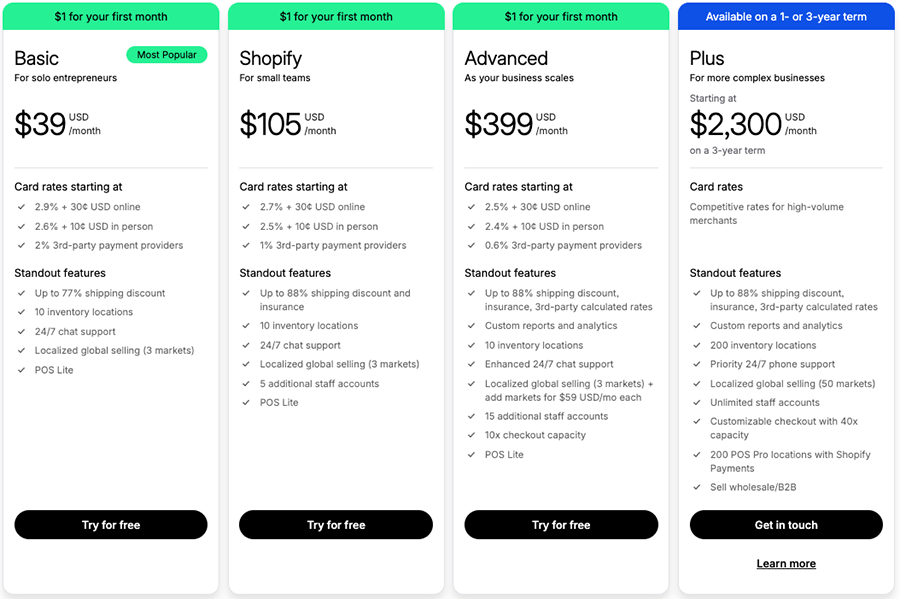
Every Shopify plan allows you to sell an unlimited amount of products, a major benefit for sellers with large inventories.
If you use the Shopify ‘Starter’ plan, however, it’s important to note that you don’t get to build a standalone online store. What you do get is the ability to sell your products through social media and messaging apps.
The ‘Starter’ plan lets you sell products via
- emails
- social media apps lie Facebook and Instagram
- SMS
- messaging apps
- sell in person at a ‘point of sale’
- a simple website (without many customization options).
You can also use the ‘Starter’ plan to embed a ‘buy button’ on an existing website (see screenshot below).
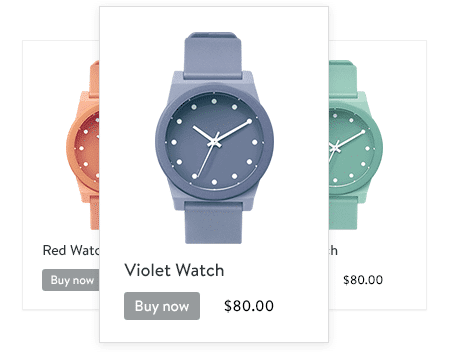
On the ‘Basic Shopify’ up to the ‘Plus’ plans, you’ll get:
- the ability to create a standalone online store
- multilingual selling features
- multiple staff accounts
- blogging tools.
The main differences between the Shopify plans involve…
- the number of staff accounts you can have — one staff account is provided with ‘Shopify Starter’ and ‘Basic Shopify’; the ‘Shopify’ plan gives you five and ‘Advanced’ lets you add 15
- the extent of the reporting features — custom report building is only available on the most expensive plans
- shipping discounts — more generous ones are available on more expensive plans
- real-time shipping quotations from carriers — these are available on the ‘Advanced’ plan or higher
- the level of multi-currency selling features — the ‘Advanced’ and ‘Shopify Plus’ plans permit you to set your own currency conversion rates.
Most merchants will find that all the key features they need are available on the the ‘Basic’, ‘Shopify’, or ‘Advanced’ plans.
However, larger ecommerce businesses may be better served by the ‘Shopify Plus’ plan. This is aimed at more corporate users, and offers advanced security, API, multi-currency and CRM integration tools along with the option to build multiple storefronts on one account. Gymshark, Lindt, Whole Foods Market, Polaroid and Red Bull are just some of the well-known companies to have used ‘Shopify Plus’ as their ecommerce solution.
OK, so we’ve looked at how much GoDaddy and Shopify cost.
But what about their features?
Let’s drill down into these, starting with something very important in website building: visuals.
Templates
Quantity of templates
Both GoDaddy and Shopify provide a wide range of templates or ‘themes’ that form the basis of your site’s design.
Shopify offers the smaller selection — with 13 free themes and 219 paid-for premium themes on offer. The premium themes have a price range of $100 to $500.

As for GoDaddy, it offers around 272 templates for its website builder. And the good news is that they are all free.

Interestingly, you don’t initially choose a template for yourself when you sign up to GoDaddy. GoDaddy asks you some questions in the onboarding process and then, based on your answers, its Artificial Design Intelligence (ADI) algorithm picks a template and creates your site for you.
If you’re not happy with GoDaddy’s choice however, you can change your template easily (more on this later in the comparison).
Quality of templates
In terms of quality, both Shopify and GoDaddy’s templates have a professional look and feel, and are based on stylish combinations of text, imagery and layout design. Both sets of templates are fully responsive — this means that your store’s layout will automatically adjust itself to suit the device it’s being viewed on (phone, tablet, desktop etc.).
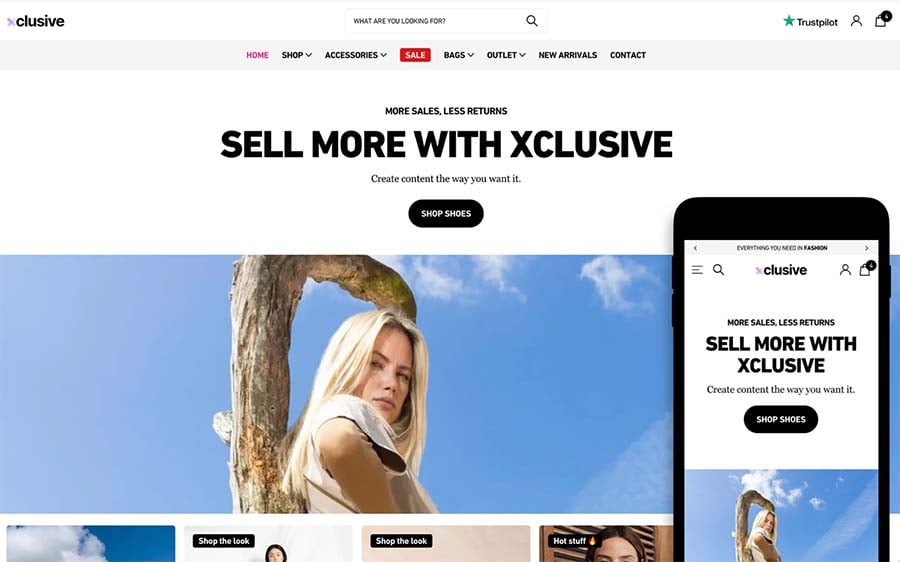
It’s a subjective area, but for me, Shopify’s templates just look that bit more attractive; and in particular, Shopify’s paid-for themes provide access to a more sophisticated design aesthetic than anything available from GoDaddy.
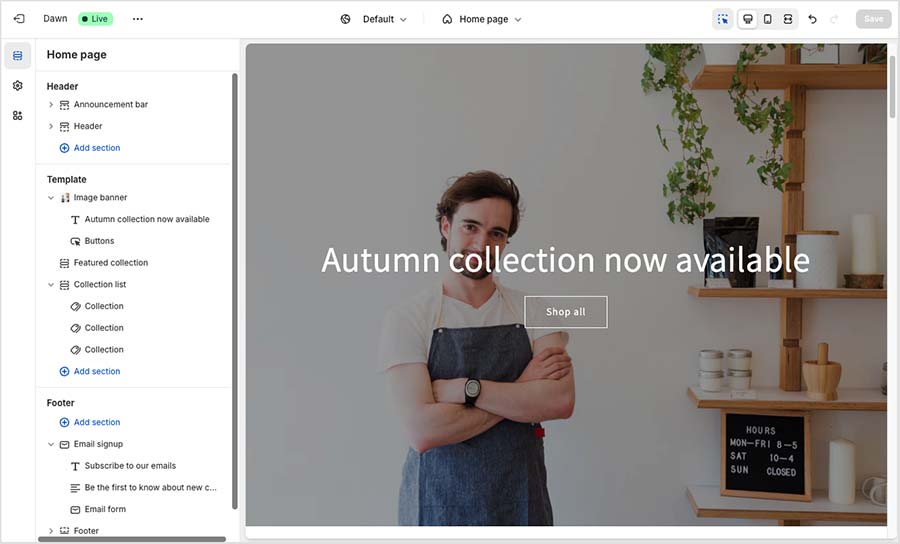
That said, GoDaddy’s templates have a respectable set of design features too. Changing colors is straightforward; you can use video backgrounds on page header sections; and when it comes to text for your site, 61 typefaces are available with very easy-to-use ‘font pairing’ controls.
The template section layouts all work well in GoDaddy and the lack of complex design options means that there’s a minimum of fuss for the store owner.
Overall though, Shopify has significantly more design features available across its template range. More of its templates facilitate:
- parallax scrolling effects
- video backgrounds
- image zoom features for your products.
The bottom line on template quality is that Shopify takes the win here.
Flexibility of templates
If you want more options for styling your store’s template, Shopify is the more obvious choice.
For a start, you get full control of the CSS and HTML code in Shopify — meaning you can customize your template much more extensively if you need to. While GoDaddy lets you add HTML section blocks to your pages, that won’t offer enough styling opportunities for many ‘pro’ store owners.
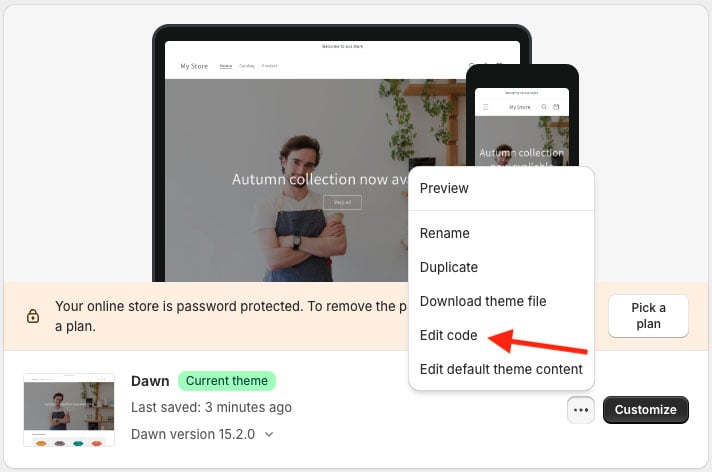
Additionally, font options are considerably more extensive with Shopify than in GoDaddy. You can choose from hundreds of bundled web fonts (to GoDaddy’s 51), and add your own fonts easily to your store too — this gives you total control over your store’s typography.
Finally, both platforms make it extremely easy to switch between templates.
In fact, with GoDaddy’s editor, this literally takes two mouse clicks and your theme is changed. All you need to do is click a simple ‘try a new look’ button and you’ll see the changes — this can help you test different styles very quickly.
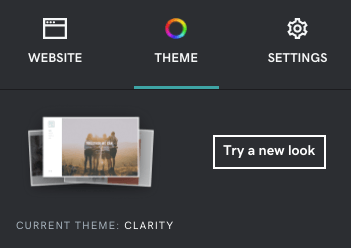
But overall, if design flexibility is a key requirement, Shopify is the better platform for you.
Interface and content management system (CMS)
Managing the content for your online store is a key part of running an e-commerce business, and thanks to their user-friendly interfaces, both GoDaddy and Shopify make it easy to do so.
Ease-of-use
Both GoDaddy and Shopify’s content management systems give you a drag and drop editor with which to add components to the pages in your online store.
Shopify’s editor gives you significantly more content sections to build and design your store than GoDaddy’s — with Shopify, you get more control over content layout, image formats and text positioning.
This means that GoDaddy’s editor is the more simplistic of the two — with less options visible in any one view. On the plus side, this makes it clutter-free and intuitive (it is also visually pleasant with a ‘dark mode’ default design).
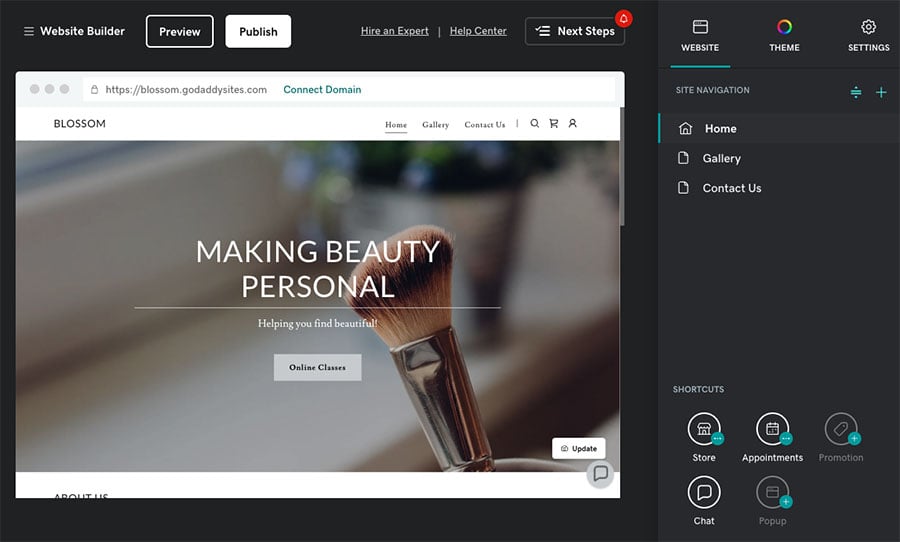
Both interfaces work in a similar way — with menus on one side of the screen containing controls that let you tweak your site’s content. The main difference here is that the key Shopify controls are positioned on the left, and the ones in GoDaddy are positioned on the right.
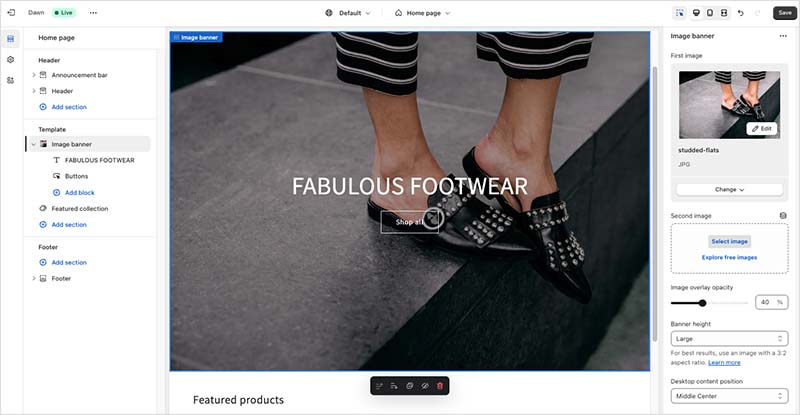
Overall, the two approaches to content management are strong — with Shopify’s CMS being more powerful, but GoDaddy’s arguably a bit easier to hit the ground running with.
This is probably because of the way that the Shopify drag and drop editor actually works. With the exception of your home page, you use Shopify’s editor to design page templates rather than edit actual pages. The templates you design then have to be applied to page content, which you edit in a rather old fashioned ‘What You See is What You Get’ HTML editor.
It would be easier if — as is the case in GoDaddy — you could just edit your page directly with the drag and drop editor.
Importing and exporting content
It’s very straightforward to bulk import and export products with GoDaddy and Shopify — both platforms allow you to do this using a CSV file.
However, limits apply: with Godaddy you can only add 100 physical products at a time via CSV on the ‘Commerce’ plan, and you can’t can’t bulk import digital products. You can add as many products as you like via CSV with Shopify, so long as your file size is under 15MB; and for bulk importing digital products, you’ll need to use a third-party app.
It’s very easy to manually add products to the two platforms though — you just fill in a few fields, add an image or two, and your product is ready to go.
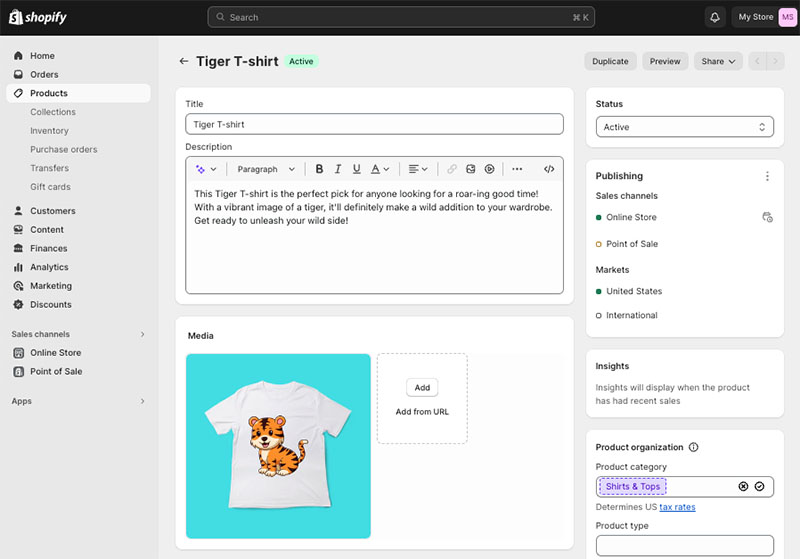
When it comes to web pages and blog posts, importing and exporting is doable in Shopify by way of third-party apps (for example ExIm) — but as these are not part of Shopify’s ‘out of the box’ offering, fees can apply.
Unfortunately, there is no similar import / export option for pages and posts available from GoDaddy.
Images and galleries
You can manipulate and edit your images easily in both GoDaddy and Shopify. But of the two platforms, GoDaddy has a slight edge here.
First, adding images to your site is extremely easy in GoDaddy. And when it comes to manipulating these images, you’ll find that GoDaddy’s integrated image editing program, ‘GoDaddy Studio’, is a very strong piece of kit — with excellent cropping, filtering, and background removal tools built in.
There’s also a handy image background removal tool built into GoDaddy – this can help improve the appearance of products that have been photographed against ‘busy’ backdrops.
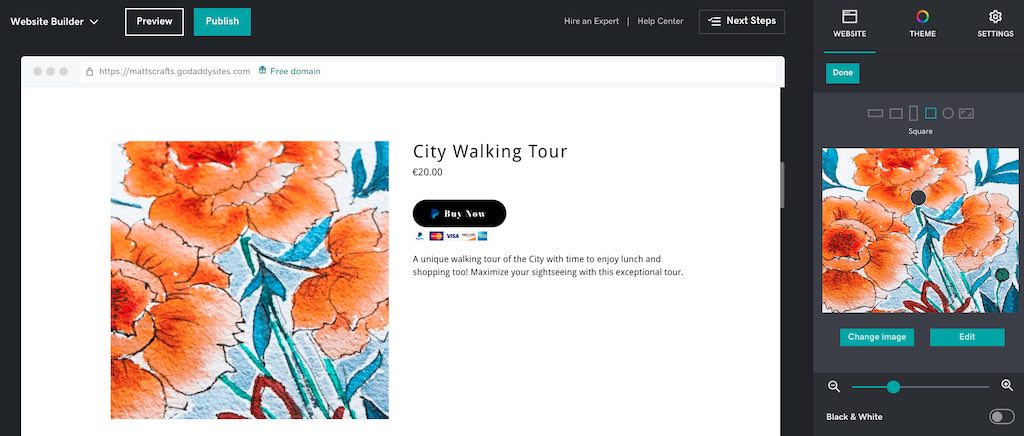
Second, resizing images so they display perfectly is a delight in GoDaddy’s designer. All you have to do is click on the image on the canvas, which opens up the resizing and scaling controls in the side menu. You can then change the fit or scale of your image through different ratios or by dragging a slider. It’s really very useful.
Now, Shopify also has an image editor and, for the most part, it gets the job done.
Like the GoDaddy image editor, Shopify lets you remove product image backgrounds, and — thanks to the recent addition of AI features in Shopify’s image editor — you can now also easily create AI-generated background scenes for your Shopify product images too.
Another particularly useful addition to Shopify’s image editor is the inclusion of a ‘focal point’ tool. This lets you set a focal point for your Shopify store’s images to ensure that the most important part of the image displays properly when it resized for smaller screens.
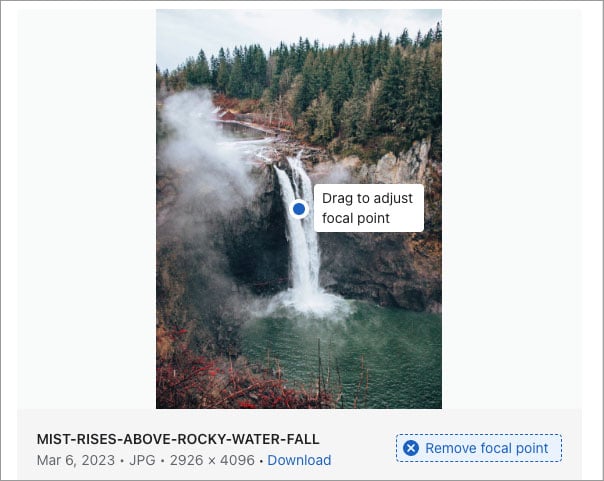
Overall though, Shopify’s image editor is just not quite a fully-featured as GoDaddy’s.
When it comes to galleries for displaying multiple images on your site, GoDaddy provides 10 types of gallery out of the box that will cover most use cases for basic stores.
Out of the box, Shopify lets you add collages, banners and slideshows to pages which allow you to display multiple images in a reasonably flexible way. If these don’t meet your requirements, Shopify’s app store gives you access to around 286 gallery apps (many of them free).
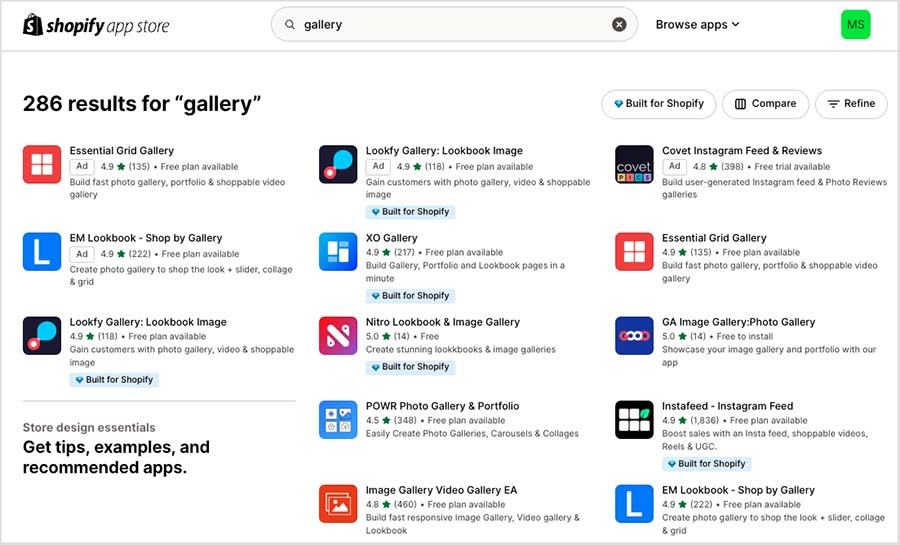
So overall, if you want a big range of options for image galleries, Shopify is the better choice. But when it comes to editing your images, it’s a win for GoDaddy.
While you’re here, check out our store builder finder tool

Our new store builder finder tool helps you find the right ecommerce platform for your needs. Simply answer a few questions about your requirements and get a personalized recommendation that’s right for you.
Blogging
Blogging is an excellent way of making people aware of your ecommerce business. High-quality blogging can help your site perform well in search results, as well as drive people into your sales funnel and convert them into customers.
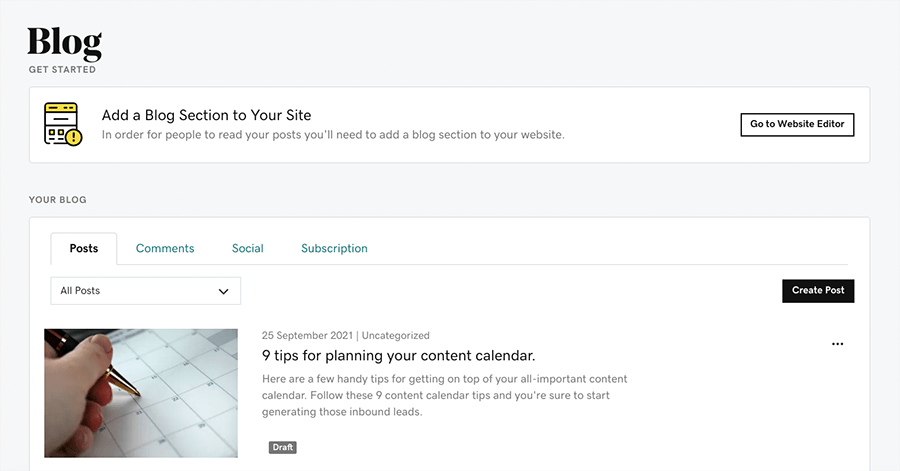
You can add a blog to your site in both GoDaddy and Shopify, and both platforms provide a similar level of blogging functionality — it’s a draw in this department.
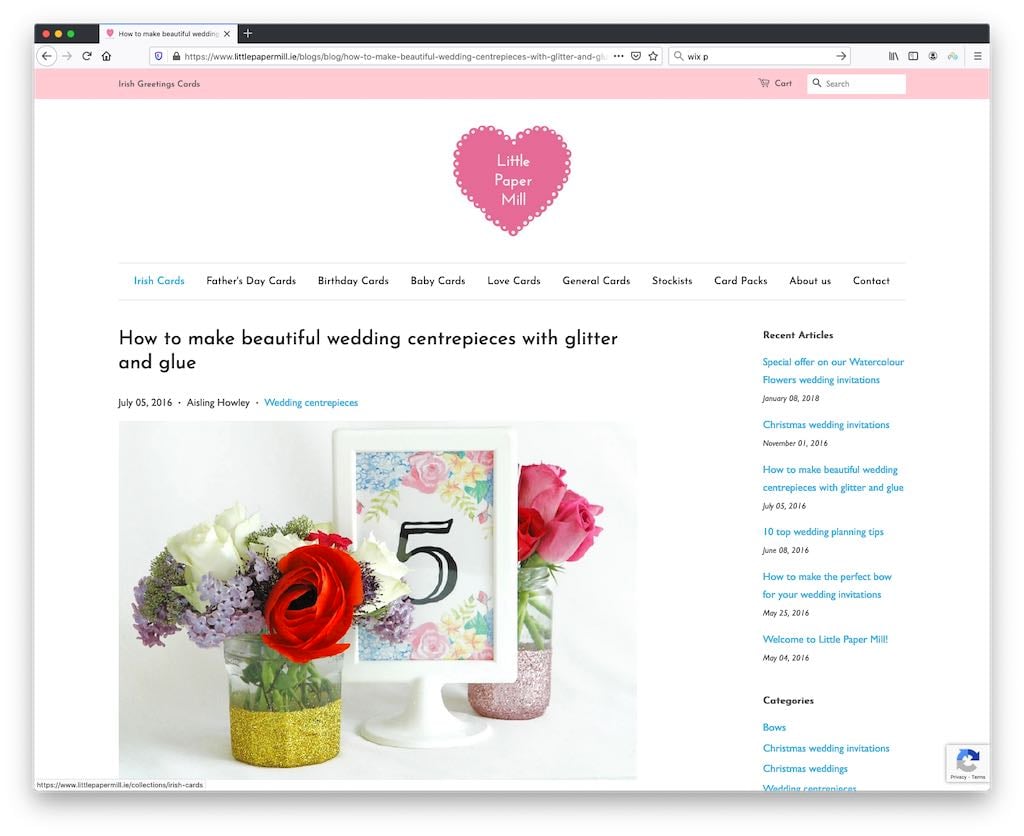
The main limitation of both platforms’ blogging features involves categorization — whereas professional blogging platforms like WordPress let you use categories, tags and custom post types, and allow you to manipulate and display your blog content in all sorts of wonderful ways, GoDaddy and Shopify limit you to either categories (GoDaddy) or tags (Shopify).
The features on offer will be fine for most users, however.
Version history and backups
When it comes to backing up your store, GoDaddy provides the better features.
Firstly, GoDaddy’s platform automatically saves changes to your site for you — unlike with Shopify, you don’t have to hit save all the time to save your content.
What’s more, if you make significant changes to your site, GoDaddy immediately creates a full backup for you (you can also do this manually if preferred). It’s very simple to revert to a previous version of it.

With Shopify, by contrast, you basically have to use a third-party app to back up your store.
So it’s a win here for GoDaddy.
Free ecommerce kit 🖥️💰
While you’re here, check out our free ecommerce kit. It’s packed with useful resources on setting up an online business, along with trials and offers for popular ecommerce apps.
Managing media
Managing your media can be done easily in both GoDaddy and Shopify.
With Shopify, you’ll find your media in the ‘files’ section of your store admin. You’re allowed 250 images per product; and your image files must be no more than 20MB in size.
For product videos, you can either make use of embedded files — for example YouTube or Vimeo videos — or upload your own videos.
Limits apply to how many videos you can upload to Shopify, but these are generous. Even on the ‘Basic’ plan, you can upload 250 1GB videos to your store.
With GoDaddy, your media lives in the ‘media library’. You’re only able to add 10 images to any one product (with a maximum file size of 10MB per image applying). For video, there is a 5GB limit for your entire store.
So overall, when it comes to product media, Shopify is the more flexible choice.
Mobile apps
Shopify and GoDaddy both give you ways to manage your store on the go, via their mobile apps.
GoDaddy has multiple apps that relate to its broad portfolio of business activities, but the one you’ll need for managing your site is called ‘GoDaddy: POS & Tap-to-Pay’ in both the Apple App Store and Google Play Store.

You should note however that this app is currently only available in the USA and Canada.
The GoDaddy app allows you to comprehensively track site activity and product orders from your phone. It works seamlessly with GoDaddy Payments — GoDaddy’s built-in payment processor — and it also offers almost all of the functionality of the desktop version of the website builder.
Additionally, both versions of the app let you take contactless payments via ‘Tap to Pay.’
User reviews of GoDaddy’s app are mostly positive — the Android version is rated 3.7 out of 5, while iOS users rate it 4.7 out of 5 in the Apple store.
Like GoDaddy, Shopify provides several apps, but the two main ones you’ll need most for managing your store on the go are ‘Shopify’ and ‘Shopify Point of Sale.’
The main ‘Shopify’ app lets you perform basic e-commerce tasks — view orders, perform inventory management etc. It is currently rated 4.7 and 4.4 out of 5 on the Apple and Google Play app stores respectively.
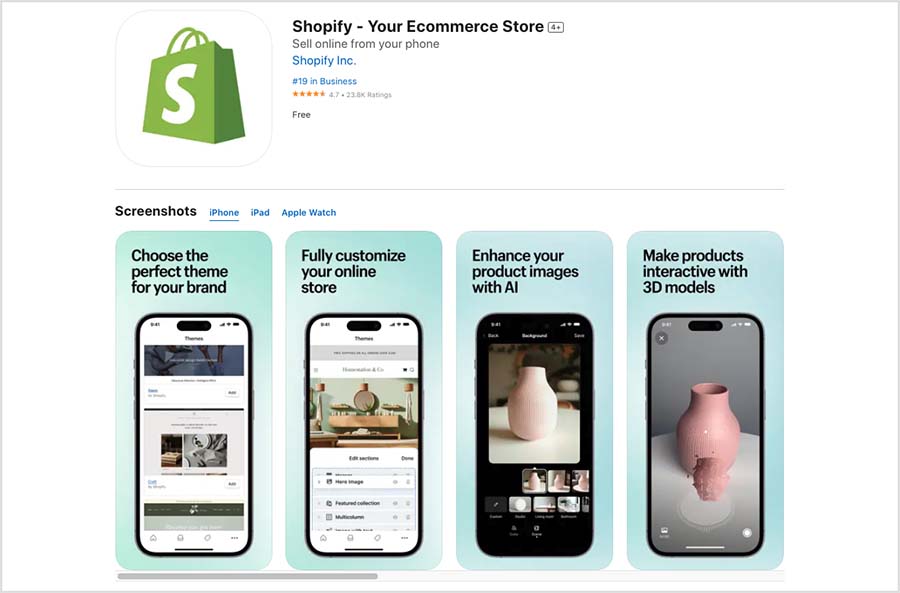
The ‘Shopify POS’ app lets you use the Shopify point-of-sale system to sell goods in a physical location and sync your inventory with your online store (and, like the GoDaddy app, it also supports Tap to Pay).
The Shopify POS app is less of a hit with Android users than its iOS equivalent — its current rating on the Google Play store is 3.5 out of 5, which compares a bit poorly with the 4.5 out of 5 rating that the iOS version gets. Many complaints mention connectivity problems.
Ecommerce functionality
If you’re comparing GoDaddy against Shopify, you are probably especially curious about which of these products is the better option for selling online.
So, let’s compare their e-commerce features and find out — starting with payment processing.
Payment gateways and transaction fees
To process payments on an online store, you need a ‘payment gateway’. This is the software that verifies credit card details and takes payment using them.
Both GoDaddy and Shopify offer their own, built-in payment gateways: ‘GoDaddy Payments’ and ‘Shopify Payments’ respectively.
GoDaddy Payments charges a credit card processing fee of 2.7% + 30c per transaction for online sales; Shopify Payments fees vary by plan and by country (in the US you can expect to pay between 2.5%+30c to 2.9%+30c for online payments).
However, Shopify Payments is available in considerably more countries than GoDaddy Payments — the latter is limited to use in the USA and Canada for now.
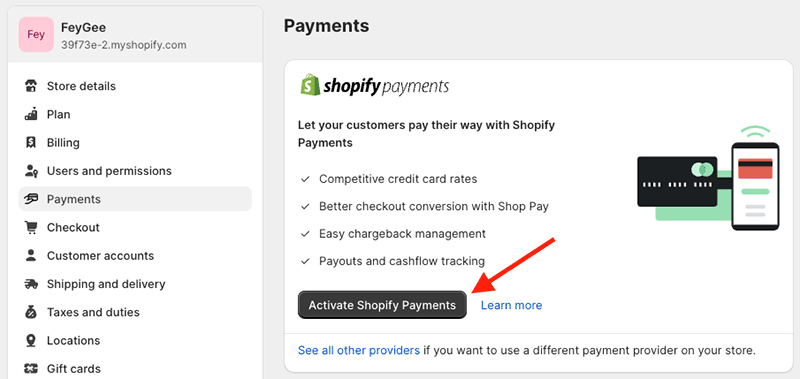
The alternative to using the built-in payment processing options in GoDaddy and Shopify is to make use of an external payment gateway. As with the built-in options, external payment gateways charge a percentage fee of every transaction made through your online store (and some charge a monthly fee, too).
Now, GoDaddy only offers integration with three external payment gateways — Paypal, Stripe, and Square. (And Square only works for users in the US, Australia, Canada and the UK.)
Shopify works with many more, however — over 100.
The key thing to watch out for here is the fact that you’ll pay an additional fee to Shopify for every transaction processed by a third-party payment gateway — this ranges from 0.6% to 2.0%, depending on your plan.
By contrast, GoDaddy does not charge you or take a cut of your sales in addition to the charges you pay for your payment gateway.
The takeaway here is that Shopify offers much more flexibility around payment gateways — but that this comes at a price.
Product options and variants
You can sell an unlimited number of products with both Shopify and GoDaddy. As for product options and variants, the two platforms take a similar approach here too, allowing you to make use of 3 product options and 100 variants.
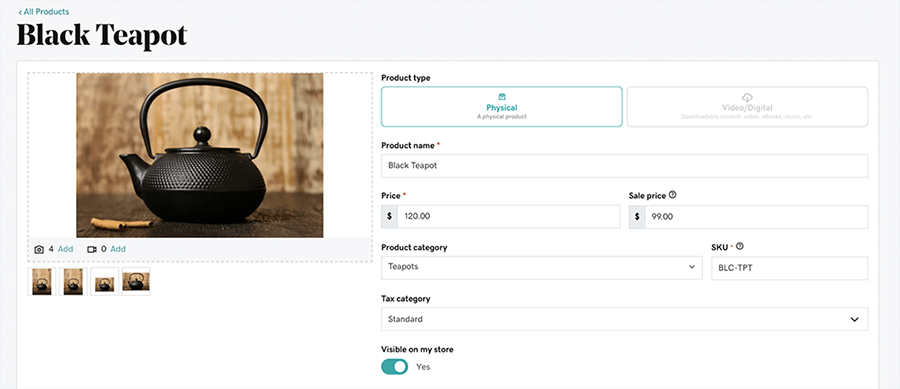
(Product options are things like size, material and color. Variants are combinations of those options — for example a red leather shoe would count as one variant, a blue suede shoe would count as another, etc.).
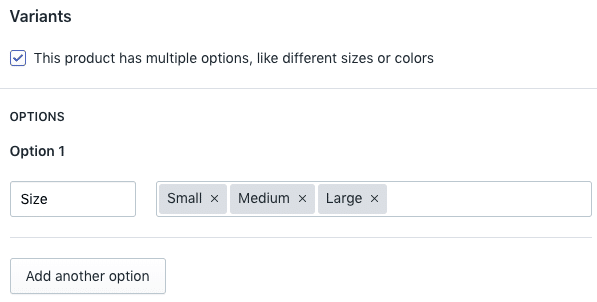
However with Shopify, you can extend these limits easily by adding third-party apps to your store (the ‘Infinite Product Options’ app being a popular choice for doing so). It’s not really possible to do this with GoDaddy, however.
Overall, the standard ‘out of the box’ offerings from GoDaddy and Shopify will cover many store owners’ requirements when it comes to product options and variants — but some merchants may find them a bit restrictive.
There are several other platforms out there with more generous approaches to product options and variants. For example, Squarespace allows 6 product options and 250 variant combinations.
With Ecwid, there are no limits to product options at all — providing sellers with big option sets far more freedom without having to pay extra or seek workarounds.
Note: Shopify merchants will get access to a 2,000 product variant limit in 2025 (with developers and ‘select businesses’ in the US already getting early access to this higher allowance in 2024).
Selling digital products
Both GoDaddy and Shopify let you sell digital products easily (eBooks, music etc.).
GoDaddy treats digital products no differently to physical products — the process for adding a digital product to your store is largely the same as when adding a physical one.
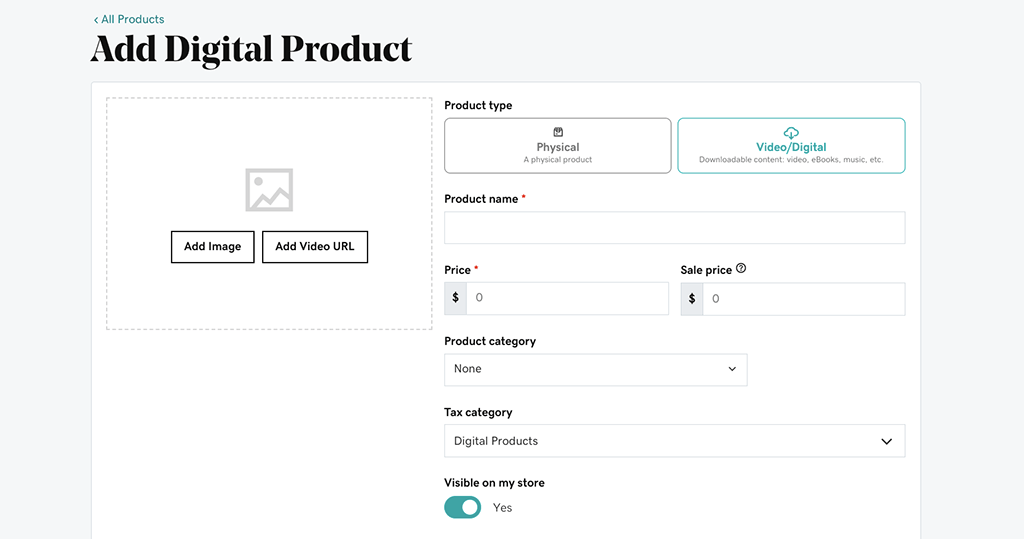
As for file size limits for your digital goods, GoDaddy allows you to bundle 10 separate files into each digital product, with a 2GB limit per file applying. This adds up to a very generous file size limit of 20GB per product.
In Shopify, working with digital goods is a bit different to creating physical products. Before you add your digital products to your store, you have to add a a downloads app to your store first.
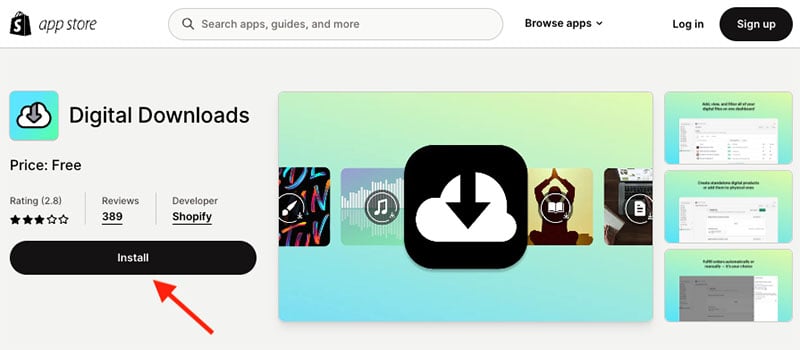
Many merchants simply opt for Shopify’s own — and free — ‘Digital Downloads’ app here. This lets you sell files up to 5GB in size.
You’ll find an additional range of digital download apps available through the Shopify app store for further functionality.
For example, the SendOwl app lets you stamp PDF files with your customer’s name — a great way to reduce fraud. It also lets you ‘drip release’ digital products to your customers over time, and it even gives you a brandable video player that your customers can use to stream files with.
The Sky Pilot app lets you bundle digital and physical products together, and sell files of up to a massive 5TB in size.
Overall, both platforms will cater to most sellers’ needs for getting their digital products out there — with Shopify providing extra bells and whistles for digital download specialists through its app store enhancements. GoDaddy wins when it comes to ‘out of the box’ file size limits, however.
Abandoned cart features
Abandoned cart functionality allows online sellers to identify and communicate with customers who add a product to their shopping cart but don’t complete the checkout process.
Both GoDaddy and Shopify provide abandoned cart features that allow you to send an automated follow-up email to visitors who don’t complete a purchase (you can include a discount code in this message to encourage them to do so). Setting this up is easy in both platforms.
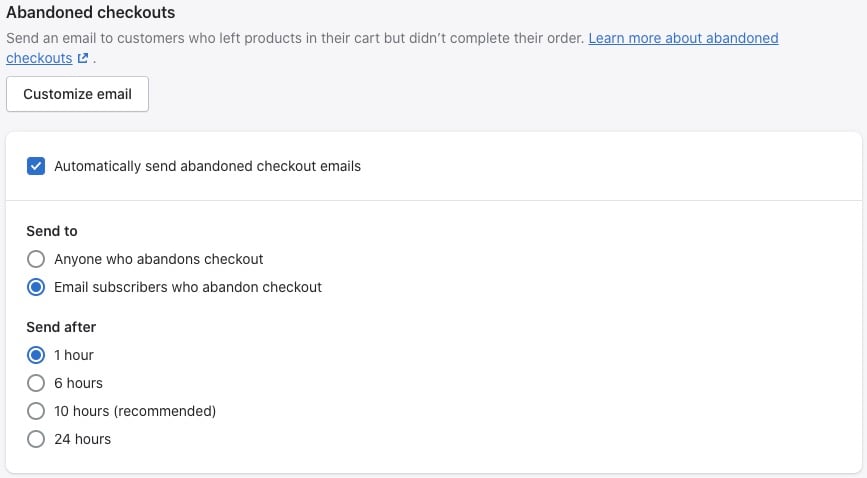
Shopify includes this feature on its $39 ‘Basic’ plan and all higher plans. With GoDaddy, you can access this functionality slightly more cheaply via its $34.99 ‘Commerce’ plan.
However, Shopify recently added some extra functionality to its abandoned cart feature. Merchants can now create these reminder emails in an easy-to-use email editor — and Shopify provides ‘editable workflows’ (pictured below) that let you create if / then rules that give you lots of control over how these emails are sent.

This makes Shopify’s abandoned cart feature considerably more powerful than GoDaddy’s.
Point of sale functionality in Shopify vs GoDaddy
Point of sale (POS) features let you use your online store to sell in physical locations like festivals, pop-up shops and brick-and-mortar stores.
POS hardware includes card readers, barcode scanners and cash registers; these enable you to take payments in person whilst keeping your inventory data fully up to date in your ecommerce website’s back end.

With GoDaddy, if you are based outside the US, you’ll have to use POS equipment provided by one of the platform’s three payment gateway providers (Paypal, Stripe, and Square).
However, GoDaddy merchants in the US and Canada can make use of GoDaddy’s own POS hardware (both card readers and screen terminals are available). These merchants can also use GoDaddy’s mobile app as a ‘virtual terminal’ for accepting card payments on a phone or tablet.

The costs for GoDaddy’s POS hardware are as follows:
- GoDaddy ‘Smart Terminal’ — $499
- GoDaddy ‘Smart Terminal Flex’ — $299
- card reader — $99.
It’s worth pointing out that GoDaddy’s POS system can be used on any of its three website plans. You don’t actually need to be on the ‘Commerce’ plan to start selling in person.
As for Shopify, it has been a POS leader in the ecommerce world for many years. So there is a much wider range of POS hardware on offer from Shopify than from GoDaddy, and you can use it in a lot more countries.
Some of the key pieces of hardware on offer includes:
- Shopify POS terminal — $349
- card readers — $49
- cash drawers — $129-$139
- receipt printers — $249-$369
- tablet stands — $149-$185
- printed gift card sleeves — starting at $59 for 250 cards.
The bad news is that to make the most of some of Shopify’s more sophisticated POS features, you will need to add its ‘POS Pro’ add-on.
This allows you to use unlimited registers, facilitate exchanges, attribute sales to staff members and do much else besides, but at a fairly high cost — ‘POS Pro’ is priced at $89 per month per location.
(You can reduce Shopify’s Pos Pro fee by 10% if you pay upfront for an annual POS Pro subscription, which reduces the price down to $79 per month.)
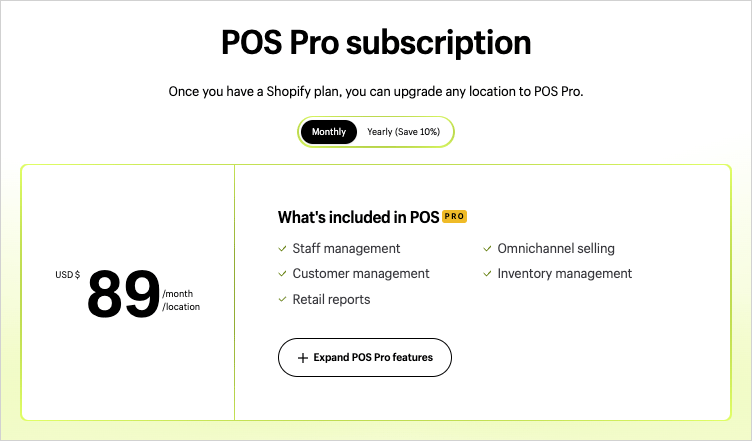
However, for simple POS applications, the built-in point-of-sale features (‘Shopify POS Lite’) will be more than adequate for most.
So, all in all, Shopify has the stronger POS offering — it has more hardware, and it’s available in more locations.
You can learn more about Shopify POS here.
Shipping
When it comes to shipping your products to your customers, Shopify is a little bit more flexible than GoDaddy. It allows you to set:
- free shipping rates
- flat rates
- price-based rates
- weight-based rates
- calculated (‘real time’) shipping rates.
GoDaddy lets you provide:
- free shipping
- flat rate shipping
- weight-based shipping
- percentage rate shipping
- calculated shipping.
(Both platforms also allow you to provide in-store pickup options to your customers.)
Shopify has an edge when it comes to how calculated carrier-based shipping works. This is because its built-in ‘Shopify Shipping’ service not only facilitates real-time shipping quotations, but gives generous discounts to users based in the US, Canada, Australia, UK, France, Germany, Italy and Spain — up to 88.5%.
GoDaddy also provides some shipping discounts, but only to US users via USPS, and only if you have a Shippo account.
Additionally, Shopify gives you — for an additional fee — the option to use your own third-party carriers for calculated shipping rates. This feature works in any country, whereas GoDaddy’s realtime shipping features (via ShipEngine) are limited to the US, Brazil and Canada.
Dropshipping
Dropshipping is a way of selling where you take an order, send it to a supplier, and they deliver the product to your client — you don’t make, store or fulfil any goods, which can reduce outlay enormously. This makes it a very popular online selling technique.
Shopify provides a very large number of integrations with dropshipping companies through its app store (which we’ll discuss shortly) — when researching this piece, I found that 604 dropshipping-related apps are currently available in the platform’s app store.
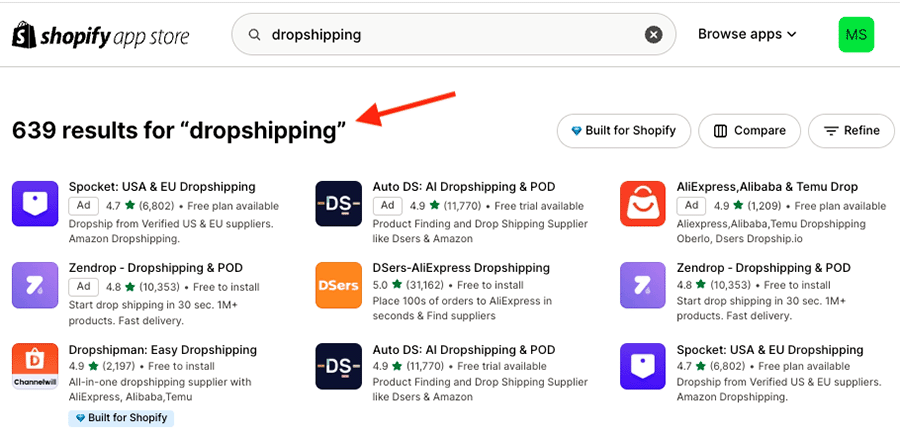
With GoDaddy, whilst it’s technically possible to dropship through its platform (you could simply accept orders and pass them onto a supplier of your choice), there are no dedicated dropshipping features that automate or simplify the process.
So, if you want to set up a dropshipping business, the better option here is definitely Shopify — it gives you everything you need to source and supply dropshipped goods.
💡 Tip: you can access some useful resources on dropshipping with Shopify here.
Personalizing products
GoDaddy has a definite advantage over Shopify when it comes to product personalization.
Its ‘product add-on’ option allows you to capture text from customers that can be used for customizing things like engraved jewellery, t-shirts and wall art.
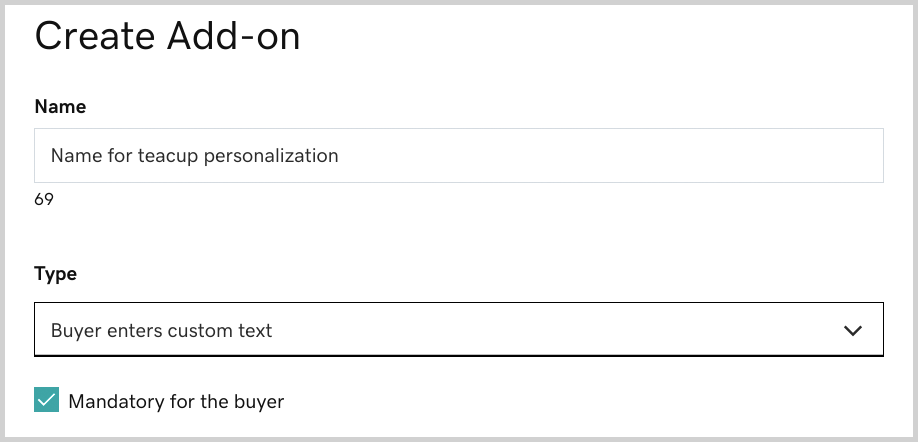
To add personalization fields in Shopify, you’ll need to do some coding or make use of a third-party app.
So a win on this front for GoDaddy.
Multi-currency selling
Displaying prices and facilitating checkout in your store visitors’ own currencies can improve sales rates considerably.
So, how easily can you do this with GoDaddy and Shopify?
Well, on a GoDaddy store, your options for displaying different currencies are very limited.
Whilst GoDaddy does work with 18 different currencies, you can only choose one to use on your store. This is fine if you only ever intend to sell your products in one market, but if you have ambitions to sell in multiple territories, it’s not ideal.
That said, GoDaddy can assist you with making international sales so long as you are based in the US, and if you use one of its marketplace integrations. GoDaddy integrates very neatly with:
- Amazon
- Etsy
- Ebay
- Google Shopping
- Walmart.
(If you’re in the UK and Australia, you currently only get access to the eBay integration; but access to the Amazon one for users based in those countries should be arriving later in 2025. Canadian users currently get access to Amazon and eBay integrations).
When your products are displayed in these marketplaces, they are automatically shown in the currency of the visitor visiting the marketplace.
However, GoDaddy imposes significant sales limits on marketplace selling with a default limit of 50 marketplace orders per month applying on the ‘Commerce’ plan. Increasing this limit involves paying additional fees of between $10 to $30 per month.
Now, multi-currency selling with Shopify — while not perfect — is far better.
Shopify’s ‘Markets’ feature lets you define selling areas — based on countries — and associate specific currencies and languages with them. If a user is in a particular market, they will be prompted to switch to the currency you’ve defined for that market.
(Note that if they go on to make a purchase in that currency, a 1.5% to 2% currency conversion fee will apply to the sale, depending on whether the user is based in the US or outside it respectively).
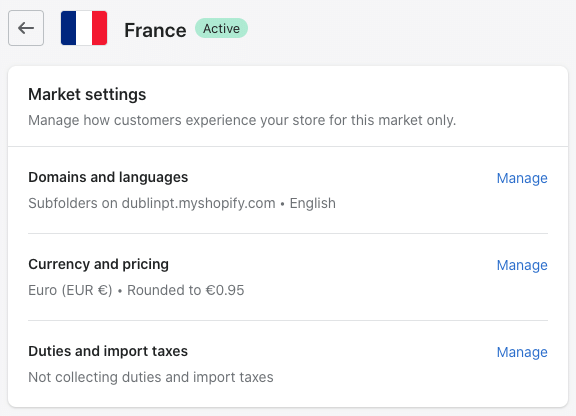
If this ‘prompt approach’ doesn’t appeal, you have the option of using a third-party app to give your store fully automated currency conversion — where instead of nudging your site visitors to change currency, your store just does it for them based on their IP address. There are quite a few apps in the Shopify app store that provide this functionality.
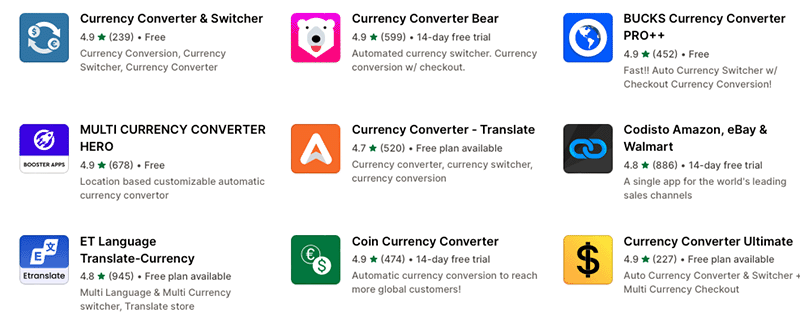
(Alternatively, and if you have deep pockets, you could subscribe to a ‘Shopify Plus’ plan, which includes fully automatic currency conversion).
Additionally, it’s worth pointing out that Shopify’s ‘Markets’ feature only works if you are a Shopify Payments user, and you can only set custom prices for particular markets if you are on an ‘Advanced’ or ‘Shopify Plus’ plan — both of which are expensive.
Another thing to note about ‘Shopify Markets’ is that you are limited to creating just three ‘markets’ on most plans. Although each market can encompass several countries, you’re restricted to using a single currency per market, essentially capping your sales to three different currencies. You can ‘buy’ more markets for your store at a cost of $59 per month each — but only if you’re on a $399 ‘Advanced’ Shopify plan. This makes multi-currency selling with Shopify very expensive.
So there’s room for improvement here, but in the context of a GoDaddy vs Shopify shootout, when it comes to multi-currency selling, Shopify is the winner.
Multilingual selling
Of the two platforms under review, only Shopify lets you sell in other languages. All plans let you sell in up to 20 languages (again as part of the new ‘Shopify Markets’ feature).
When you create a version of your Shopify store site in a new language, its domain will end with a folder reference to the language in question— myshop.com/fr/ for French etc., myshop.com/de/ for German etc. If you prefer, you can use country level domains too (i.e., myshop.fr or myshop.de).
Unfortunately for GoDaddy users, there is no multilingual functionality available at all — so it’s another clear win for Shopify here.
Tax calculations
Automatic tax calculation is another area where Shopify offers the better features.
WIth Shopify, most users can avail of automatic tax calculation for their products — and on all plans too. Figuring out individual tax calculations can be massively time intensive, so Shopify’s tax calculation feature is a great asset for online sellers.
GoDaddy users on its ‘Basic’ and ‘Premium’ plans need to do a manual sales tax setup process for each and every product in their stores.
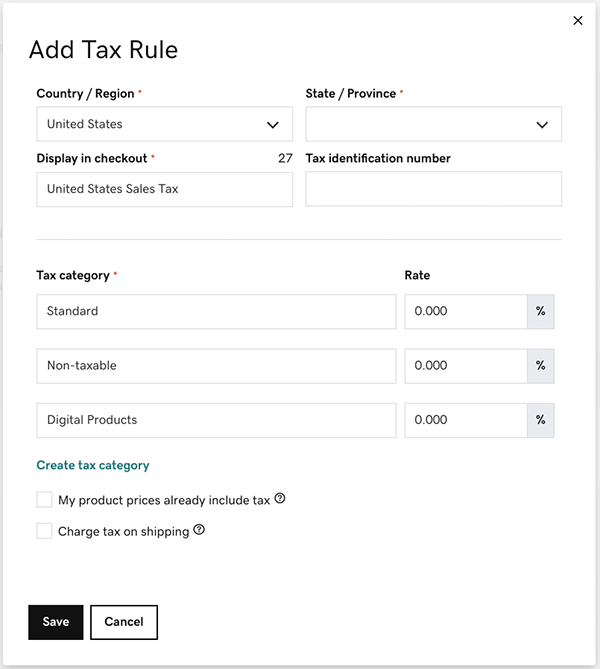
However, ‘Commerce’ plan subscribers get access to automatic tax calculation via an integration with the tax calculation service Avalara.
Shopify has a particular advantage over GoDaddy when it comes to applying tax rates to digital products — especially where EU customers are concerned.
In the EU, digital products are subject to a tax called VAT MOSS (Value Added Tax Mini One Stop Shop). This requires sellers of digital products to consumers in the EU to apply tax on these products on a country-by-country basis.
Shopify automates the calculation of VAT MOSS on digital products via its free ‘Digital Downloads’ app. With GoDaddy however, it’s a matter of entering the relevant rate for each EU state, one at a time.
While you’re here, download our free ecommerce e-kit
For a limited time, we’re offering our readers some excellent free tools. Sign up free to immediately receive:
- our online store comparison chart
- a downloadable cheatsheet on how to create an online store
- our SEO, blogging and ‘how to start a business’ cheatsheets
- extended free trials and discount codes for essential business apps
- our latest tips on ecommerce and growing a business
Analytics
If you’re running an ecommerce business, understanding how your users behave and interact on your site is absolutely essential.
Now, it’s relatively easy to set up Google Analytics with both GoDaddy and Shopify — allowing you to get to know your customers’ behavior and measure all sorts of traffic data.
But what about the analytics features each platform provides ‘out of the box’?
Well, GoDaddy provides you with a personalized analytics tool called ‘GoDaddy Insight’. This ‘smart tool’ provides you with statistics on:
- the number of site visitors
- the number of sales through your site
- social media effectiveness
- customer engagement
- reviews of and comments on your company.
On top of all that, GoDaddy Insight makes industry-specific recommendations based on data from competitors in your sector.
These recommendations come in the form of an action plan; you also get an ‘insight score’ out of 100 which lets you know how your site compares against those of your competitors. All this is very useful for store owners who lack experience in digital marketing and website analytics.

With Shopify you can access a very extensive range of reports on your site activity, sales and customers.
These include:
- finance reports
- sales reports
- customer reports
- acquisition reports
- behavior reports
- custom reports.
The only downside worth noting here is that to access custom reporting you’ll need to be on an expensive ‘Advanced Shopify’ or ‘Shopify Plus’ plan.
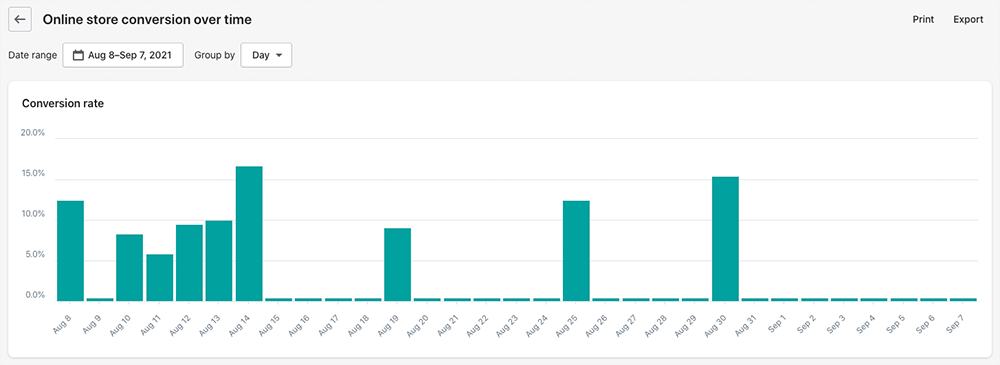
If you’re new to ecommerce, you may find GoDaddy’s smart reporting assistant a less intimidating way to get to grips with analytics for your store — it makes analytics a bit like playing a game.
However, for more professional reporting functionality and a greater range of options with which to crunch your data, the better choice (albeit at a more expensive price) is Shopify.
Integration with other apps
A key difference between GoDaddy and Shopify is the extent to which you can integrate the platforms with third-party tools, or add bespoke functionality to your store.
Now, it’s fair to say that GoDaddy provides a lot of built-in functionality for design, marketing, payments, bookings, shipping, and SEO. It provides excellent integrations with the biggest online marketplaces. And, when it comes to social selling, it covers several of the main bases like Facebook, Instagram, Twitter and Google.
For a lot of merchants, this will be perfectly sufficient.
But unlike most other popular e-commerce solutions, GoDaddy doesn’t have an app store that lets you buy add-ons that increase your store’s functionality, or integrate it with other tools and services.
Not only is GoDaddy lacking an app store, but it also lacks any clear way to integrate with tools outside the GoDaddy platform. A particular omission here is the lack of an official integration for Zapier — a ‘syncing’ tool that lets apps work together, even when official integrations for them don’t exist.
The opposite is true of Shopify. Its app store offers around 13,000 apps that allow you to integrate the platform with a wide range of other services and add additional features to your store.
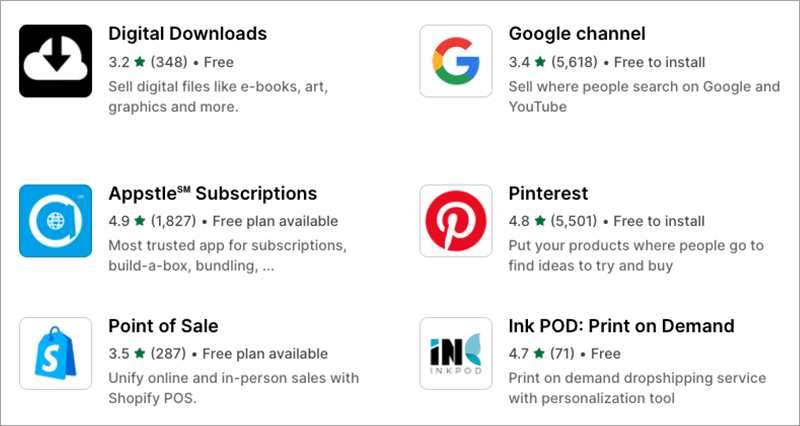
This provides sellers with a lot more versatility when it comes to things like:
- email marketing campaigns
- dropshipping
- reporting
- customer service.
In addition to the apps in the Shopify app store, Shopify also works with Zapier — adding over 5,000 integrations and automations to proceedings.
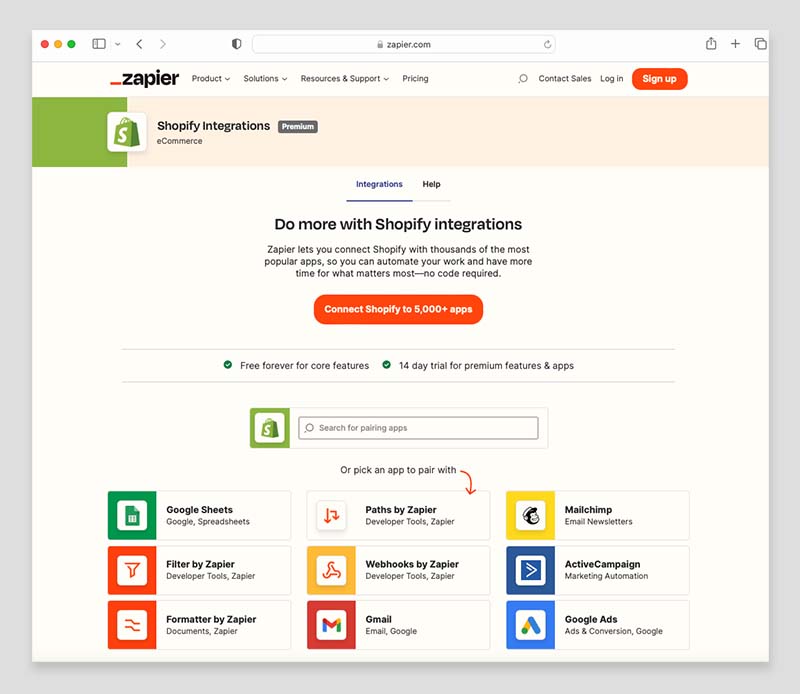
The bottom line is that Shopify gives ecommerce site owners significantly more access to tools and integrations with which to sell or promote their products than GoDaddy.
Forms and data capture
Both GoDaddy and Shopify provide the option to add data capture forms (contact forms, newsletter forms etc.) to your store.
Shopify provides very basic contact and newsletter signups form that you can add to your store’s pages. However, adding custom fields to them requires some custom coding.
If you want to add pop-up forms to your Shopify store, you can use the new ‘Shopify Forms’ app. You can customize the design of these forms to match your brand, and the app lets you configure exactly when you want the form to appear on your page (immediately, after 10 seconds, after 30 seconds, etc.).
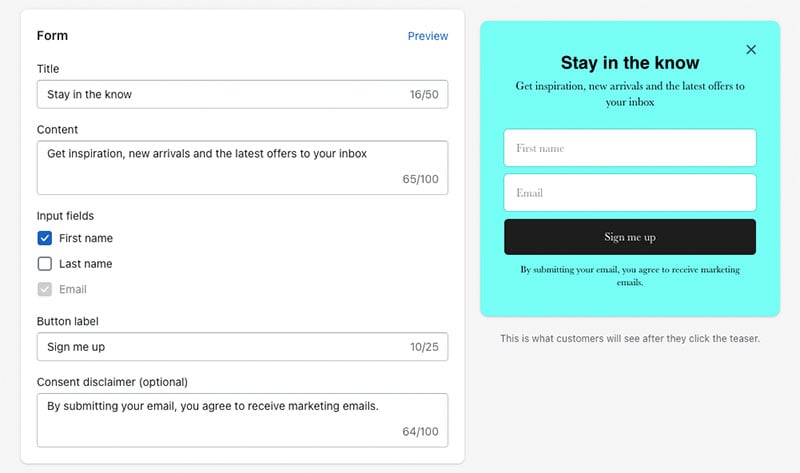
If you want to create more sophisticated forms in Shopify, you can make use of around 900 third-party form apps in the Shopify app store (usually at a price, however).
GoDaddy also provides some simple contact forms — and it is easier to add custom fields to these than Shopify’s.
Form design aside, the key difference in the two platforms’ approaches to data capture is that Shopify enables you to send your data to more places; its app store provides integrations for key email marketing campaign tools like GetResponse, AWeber, Mailchimp and Campaign Monitor.
With GoDaddy, your form data is just sent to your store account — you can only really make use of it via the built-in GoDaddy marketing tools.
So, both Shopify and GoDaddy provide reasonable ‘out of the box’ functionality when it comes to building custom forms. However, many ecommerce platforms — including key competitors Wix and Squarespace — offer more flexible built-in form creators that reduce the need for coding or third-party apps.
Email marketing in GoDaddy and Shopify
A key part of running an ecommerce website is email marketing — sending e-newsletters to your mailing list is one of the best ways to generate sales.
So, in common with a lot of other ecommerce platforms, both GoDaddy and Shopify now offer built-in email marketing tools.
Both companies’ offerings here are fairly similar in terms of functionality — you can use them to send basic but professional-looking newsletters promoting your products, and this will suit a lot of merchants perfectly well.
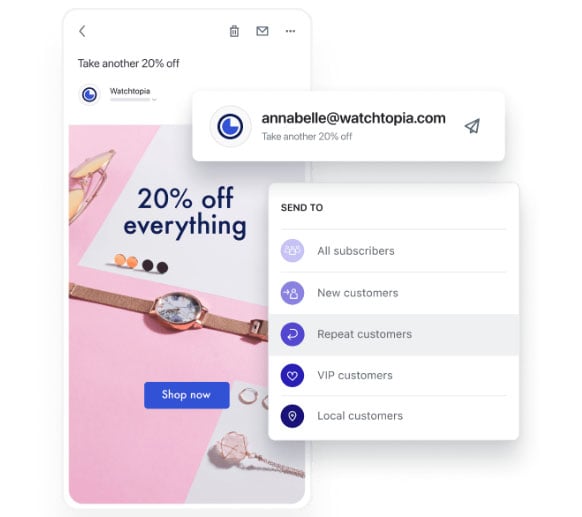
However, if you’re looking for the sort of advanced autoresponder capabilities or marketing automation features that tools like AWeber and Mailchimp provide, you won’t yet find available in either platform yet.
(That said, Shopify is improving on this front, increasingly offering more automation and trigger-based emails).
The main difference to focus on between the two platforms’ out-of-the-box email marketing tools is less about functionality, and more about the send limits: Shopify lets you send up to 10,000 emails per month for free, with a $1 fee applying to every additional 1,000 emails sent after that.
(If you send more than 750,000 emails per month, this fee drops to $0.55 per additional 1,000 emails).
GoDaddy is more generous. You can send up to 25,000 emails per month on its ‘Premium’ plan; this limit is increased to100,000 emails per month on its ‘Commerce’ plan.
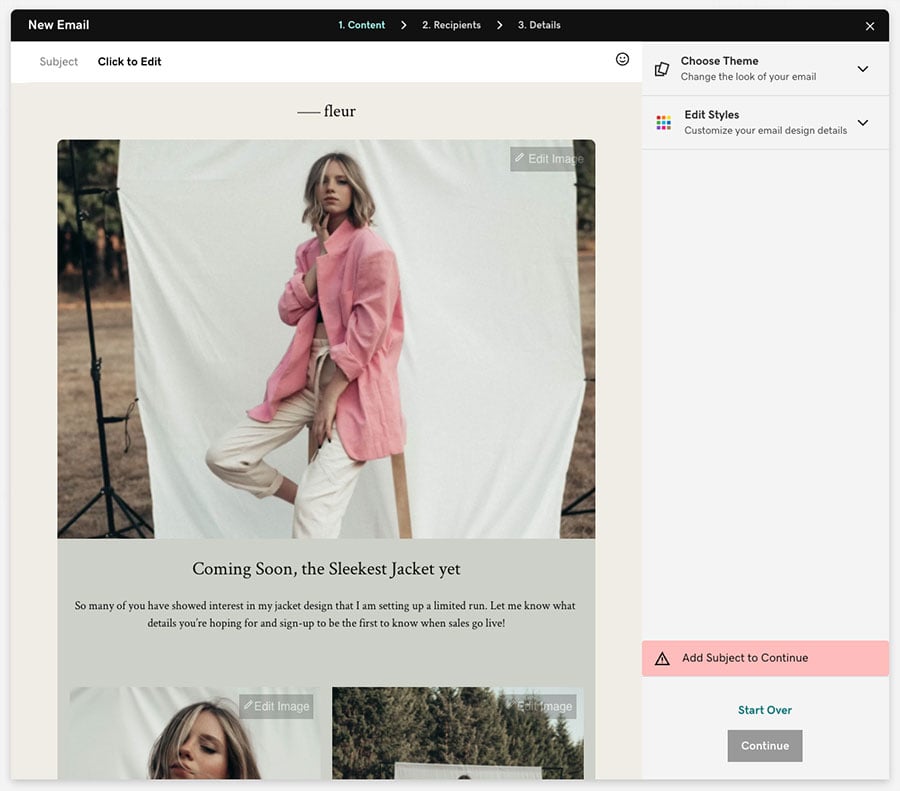
The other thing worth noting is that while GoDaddy’s email marketing tool is firmly baked-in to its interface, using Shopify email marketing requires installing a free app — the appropriately named ‘Shopify Email.’
So compared to Shopify, I’d say that GoDaddy has the edge when it comes to built-in email marketing features — they are more generous in terms of send limits, and more easily accessible. However, because you can hook Shopify up to most email marketing platforms (which is not the case with GoDaddy) you could argue that Shopify ultimately offers more options when it comes to email marketing.
Search Engine Optimization (SEO)
SEO is a vital part of e-commerce — without organic traffic, you’re going to suffer from a sales perspective. So how do GoDaddy and Shopify stack up on this front?
GoDaddy SEO
Like many of GoDaddy’s website and store builder’s other features, the SEO tools on offer from the platform are aimed at relative beginners.
GoDaddy’s builder does certain important SEO things well — it provides:
- a free SSL certificate for every site, giving your site a secure, https:// connection (something Google is very keen on)
- an automatically generated XML sitemap (this helps search engines crawl and index your pages more easily)
- fully responsive, mobile-friendly templates (Google’s preferred approach to web design)
- an easy way to edit page meta descriptions (the site descriptions that appear in search results)
- access to ‘alternative text’ tags for images (these help search engines — and people with a visual impairment — understand your content better)
- a 99.9% uptime guarantee for your site.
A particularly useful aspect of GoDaddy’s SEO feature set involves keywords.
The built-in ‘optimization wizard’ — available on the standard plan and higher — provides some very accessible step-by-step assistance for working on your site’s keywords and on-page content, looking at your content and making keyword suggestions for you automatically.
In effect, it helps ensure that first-time store owners are (possibly without realizing it) optimizing page and product content across their site.
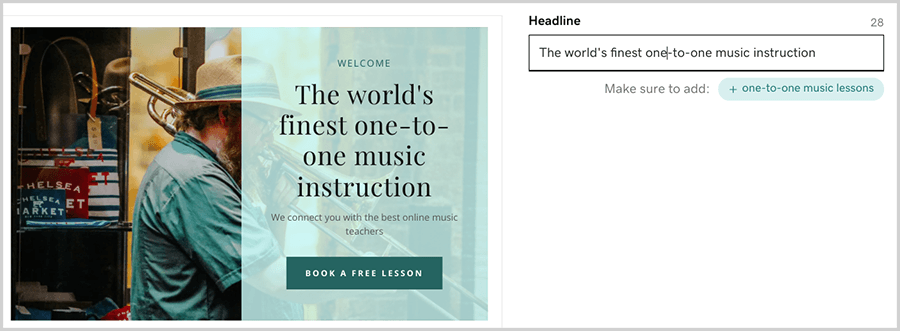
However, there are a few major limitations to GoDaddy’s SEO features:
- There’s no access to the code of your template (thus making it hard for you or a develop to customize your site in a way that will meet Google’s Core Web Vitals requirements).
- GoDaddy provides limited editing of page URLs (Google looks at URL structure when categorizing content).
- You don’t get any control over 301 page redirects (these are used to tell search engines what to index if an existing page gets renamed or deleted).
These omissions are not at all ideal and have the potential to hold you back from an SEO perspective.
Shopify SEO
Unlike GoDaddy, Shopify allows you almost complete freedom when it comes to your site’s SEO. The platform lets you configure just about any SEO element, including URL, redirects and page titles.
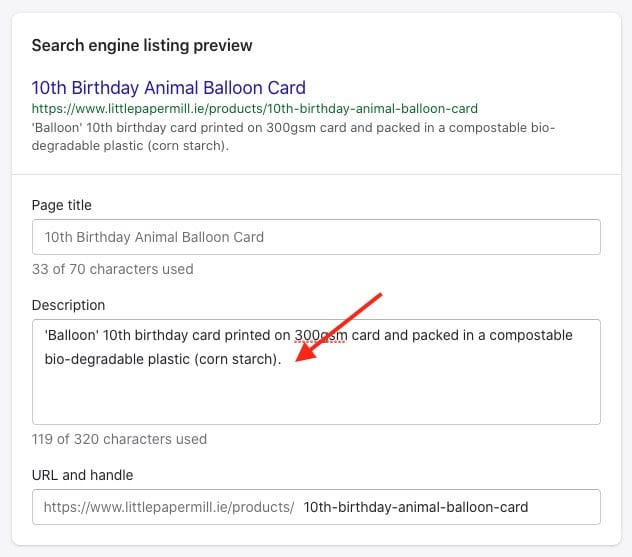
And if you want to improve your site’s loading times and visual stability (two of Google’s Core Web Vitals criteria), you can do this more easily in Shopify — either by modifying your site code or by using using an app from the Shopify app store to help you.
Additionally, a new performance dashboard is available that helps store owners more easily understand and meet Core Web Vitals requirements (see my screenshot below).
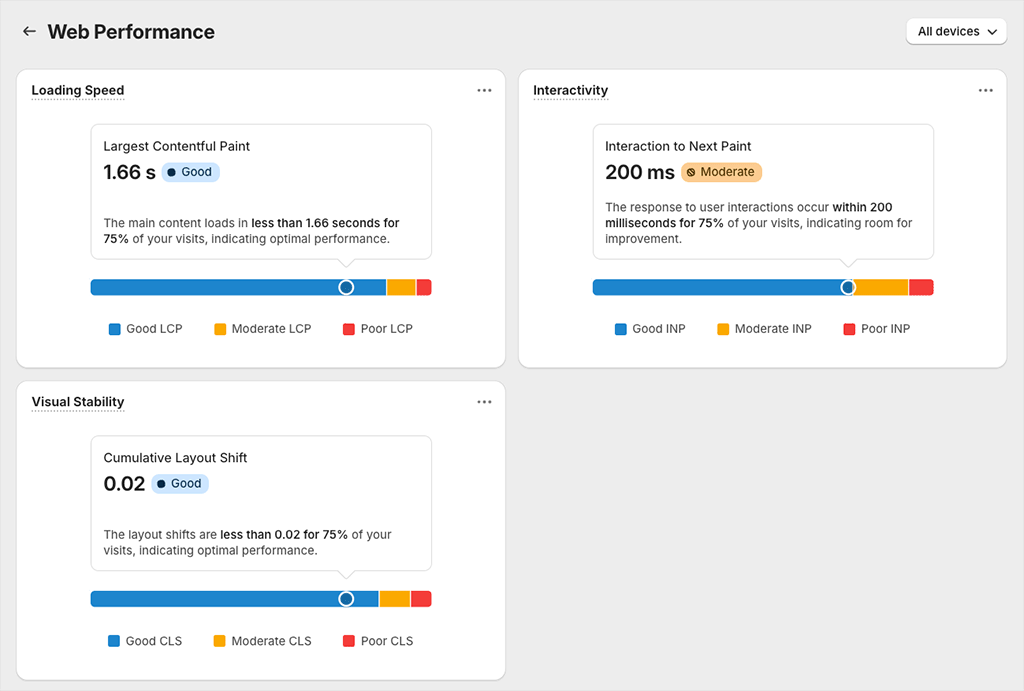
All in all, Shopify has a significant edge over GoDaddy when it comes to SEO.
Hiring GoDaddy to do your SEO
One thing about GoDaddy that might appeal to SEO novices is that you can pay GoDaddy to optimize your site for you via its ‘SEO Services’ offering. Pricing for this bespoke one-to-one SEO service is negotiated based on your SEO needs.
Some store owners will be happy to hand-over their SEO work to GoDaddy. But as discussed above, if you want to do it all yourself, you’ll find that the technical SEO features of GoDaddy are relatively basic in nature.
Customer support
Both GoDaddy and Shopify offer comprehensive customer support.
GoDaddy provides live chat and phone support across all its plans. Phone support is 24/7 in most regions (live chat is 24/7 in all) and locating the company’s contact number couldn’t be easier — you’ll find it under the ‘contact us’ option in the main menu.
In addition, GoDaddy provides a support account on Twitter, Whatsapp support in some regions, 24/7 SMS support in the US and a range of help center articles and video tutorials.
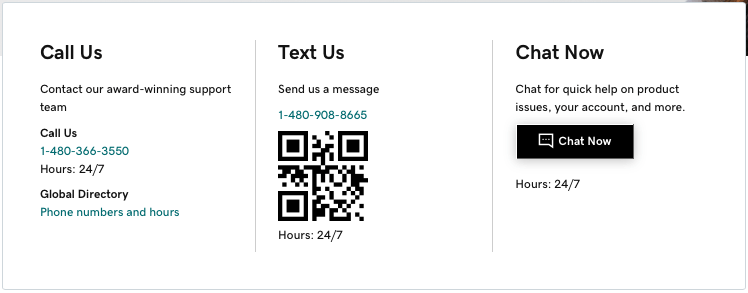
(A quick word of warning about GoDaddy’s help pages, however: be sure that the help article you access is actually for the GoDaddy website and store builder tool. It’s quite easy to discover you’re reading an article that relates your search term but is actually about an entirely different GoDaddy product!)
As for Shopify’s customer support, you can avail of 24/7 live chat and email support.
(Phone support is reserved for Shopify Plus customers only).
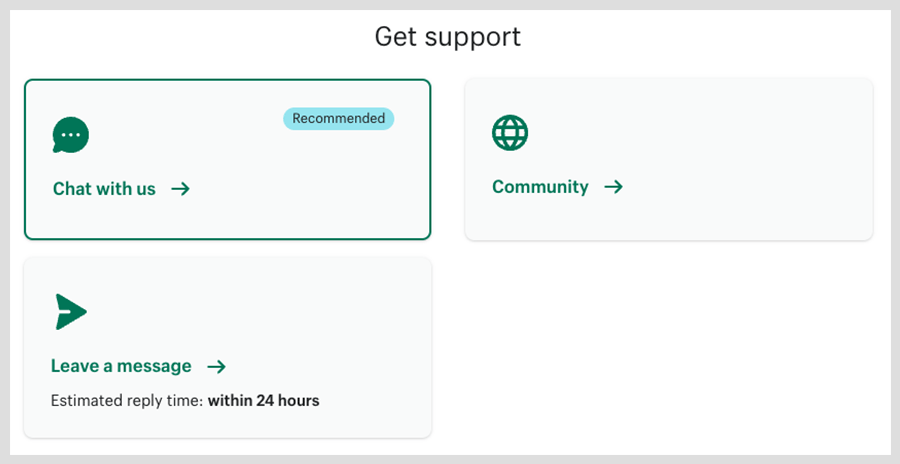
Finding the Shopify contact details is only possible once you’ve already searched for an answer in the help center search facility. This makes GoDaddy the more immediately ‘contactable’ company of the two.
Finally, with GoDaddy, if you have a problem with your template, you’re pretty much guaranteed to get the answers from its support team directly. However, with Shopify, this is not always the case. For support with many of its paid-for templates you may have to contact the theme developer directly.
Overall, both Shopify and GoDaddy offer comprehensive support options — with GoDaddy taking a slight win here due to the fact that it provides a phone support service on all plans..
Shopify vs GoDaddy: the verdict
Ultimately, in a Shopify vs GoDaddy comparison, it’s hard not to conclude that Shopify is the more powerful of the two platforms. Its much wider range of selling tools lets you create a more sophisticated, bespoke online store; and its multilingual and multicurrency features give you the scope to scale your ecommerce business internationally in ways that are not possible with GoDaddy.
Whereas GoDaddy is geared mainly towards solopreneurs and small business owners, the Shopify platform caters for a much wider range of business types.
If you’re an absolute e-commerce beginner that only needs to sell online in one currency and language, there is nonetheless an argument for choosing GoDaddy: its user-friendliness, all-in-one nature and its cheaper pricing may appeal.
But for professional merchants, or those with ambitions to grow a significant online business, Shopify is unquestionably the better option.
I’ll sum up with some key pros and cons of both platforms — and the reasons why you might choose Shopify or GoDaddy as the solution for your ecommerce project. Feel free to ask any questions or share feedback you may have about either platform in the comments section below!
Reasons I would use GoDaddy over Shopify
- You can use the platform entirely for free.
- Building a standalone online store costs less money with GoDaddy, and there are less hidden charges to worry about.
- All its themes are free — most of Shopify’s range are paid-for.
- GoDaddy ecommerce features are really easy to use — novices may find the platform easier to hit the ground running with.
- It’s easier to capture custom data for personalized products with GoDaddy.
- Its email marketing send limit is considerably more generous than Shopify’s.
- Backup and revision history features are included with GoDaddy, but not with Shopify.
- Its image editing tools are more powerful than Shopify’s.
- GoDaddy doesn’t apply transaction fees when you use a third-party payment gateway; Shopify does.
- If you like that feeling of having ‘everything under one roof’, GoDaddy’s platform may appeal more.
Reasons I would use Shopify over GoDaddy
- You can sell online in multiple currencies and languages with Shopify; this is not really possible with GoDaddy.
- Shopify is a considerably better option for dropshipping.
- Its SEO features are much better than GoDaddy’s.
- Shopify’s app store makes it easy to integrate the platform with a huge number of other services; GoDaddy doesn’t really offer anything comparable on this front.
- Because it works with more external payment gateways, you can use more payment methods with Shopify.
- Shopify’s reporting features are considerably more extensive than GoDaddy’s.
- Design customization options are far more extensive in Shopify than in GoDaddy.
- You can connect a Shopify site to most of the major email marketing apps; GoDaddy restricts you to using its built in email marketing option.
- The point-of-sale features in Shopify are considerably stronger.
- Full HTML and CSS access is available in Shopify.
- Shopify’s automated sales tax features are more comprehensive than GoDaddy’s.
Alternatives to GoDaddy and Shopify
GoDaddy and Shopify aren’t the only ecommerce platforms available — there are lots of other ecommerce tools and website builders to consider!
A key alternative to GoDaddy and Shopify is BigCommerce — like Shopify, it’s a dedicated ecommerce platform, rather than a more ‘general’ website builder, and accordingly it has a much larger set of ecommerce features than GoDaddy – more tools to help you build a truly professional store.
(And, arguably, it boasts more ‘out of the box’ selling features than Shopify too.)
Read our BigCommerce review to find out more about this platform.
If you’re not really focused on ecommerce and you want to build a general-purpose website, it’s worth taking a look at Squarespace and Wix — two website builder platforms that combine a good range of ecommerce features with more general website building tools.
Check out our Wix review, our Wix vs GoDaddy comparison, our Squarespace review and our Wix vs Squarespace vs WordPress comparison for more details on both platforms.
And you can learn about the key differences between Shopify and Squarespace here.
WordPress is another great option for building an ecommerce website — but depending on whether you use the hosted or self-hosted version, you may need to factor in a bit more configuration or development time if using this platform. Our Shopify vs WordPress post will be of relevance here.
Finally, you could consider Big Cartel as a budget option — it lets you sell up to 5 products completely free. You can read our Big Cartel review here.
Shopify vs GoDaddy FAQ
Can I use GoDaddy and Shopify for free?
Yes. GoDaddy offers an entirely free plan, and Shopify offers a 3 day free trial that can be extended to 3 months for $1 per month.
Which is easier to use, GoDaddy or Shopify?
Thanks to its more simplistic interface, GoDaddy is arguably easier to use than Shopify. However, this is partly because it has many less selling features.
Is GoDaddy good for ecommmerce?
The main argument for using GoDaddy as your commerce platform is that it is cheap, very easy to use and comes with a good range of basic selling tools. However, it lacks many ‘pro’ features that you’d find in dedicated e-commerce platforms like Shopify, including the option to sell in multiple currencies and languages. And due to its lack of an official app store or Zapier integration, it’s hard to get GoDaddy to integrate with other key e-commerce applications.
Is it easy to switch from GoDaddy to Shopify?
How complex a job this will be will depend largely on on how many products you have in your store, and how much other content you have on your site — but in most cases, switching from GoDaddy to Shopify is pretty straightforward. You will need to export your products to CSV format first (for import into Shopify), and copy and paste any pages blog posts you want to move across.
Comments (2)
How does Go-Daddy and Shopify notify you of an online sale? Do they send you an email and can you set the format for this email?
I run a manufacturing workshop. It is important that I can get stable order data from my ecom site so that I can import this directly into my exisiting spreadsheets and databases.
Hi Owen
Both platforms give you email notifications of sales yes, or you can log in periodically and see a list of the latest ones. You can export order information into CSV format. In both cases you won’t really be able to configure much however – it will be a case of copy and pasting rows of data, or simple data entry into your existing systems.
Hope this helps?
Chris